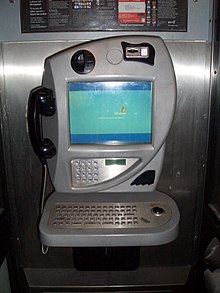बुत लोदर
कम्प्युटिङय्, बूटलोडर धाःगु बूटस्ट्रापिङ प्रक्रिया ख गुकिलिं छ्यलामिं कम्प्युटर सिस्तम चायेकिबिलय् अपरेटिङ्ग सिस्टमयात शुरु याइ।

बूट लोडर
सम्पादनआपालं कम्पुटरतयेसं मेमोरी (रोम वा र्याम)य् दूगु कोड जक्क सञ्चालन यायेफु। आधुनिक अपरेटिङ्ग सिस्टम हार्ड डिस्क वा गब्लें-गब्लें लाइभसिडि, फ्ल्याश ड्राइभ वा मेमेगु भोलाताइल स्तोरेज दिभाइसय् स्वथनातःगु जुइ। कम्प्युतर दकलय् न्ह्यः पावर अन याइबिलय् कम्प्युतरया मेमोरीइ अपरेतिङ्ग सिस्तम दइमखु। कम्प्युतरया हार्दवेयरं जक्क दिस्कं प्रोग्राम लोद याइगु थें न्याःगु जटिल ज्या यायेफैमखु। अतः, छगू प्यारादक्स खनेदु गनकि अपरेतिङ्ग सिस्तम मेमोरीइ लोद यायेत न्हापा हे लोद जुयाच्वंगु अपरेतिङ्ग सिस्तम मा।
थ्व प्यारादक्सया समाधान बूतस्त्राप लोदर वा बूत लोदरनांया चिधंगु कम्प्युतिङ्ग प्रोग्राम छ्यला जुइ। थ्व प्रोग्रामया छगू जक्क ज्या मेगु सफ्तवेयर लोद याना अपरेतिङ्ग सिस्तम शुरु यायेगु ख। आपालं, मल्तिपल-स्तेज बूत लोदर छ्यलाय् वः, थन्याःगु प्रोग्रामय् थी-थी चिहाकःगु प्रोग्रामतयेसं छगूलिं मेगुयात सःता उकिया दकलय् लिपाया प्रोग्रामं अपरेतिङ्ग सिस्तम लोद याइ। बूतस्त्राप लोदर धाःगु नां छमेसियां थःयात हे बूतस्त्राप छ्यला सालाच्वंगु किपालं वःगु नां ख।
न्हापा-न्हापाया प्रोग्रामेबल कम्प्युतरय् फ्रन्त प्यानलय् छ-हाकः तगल स्विच दइगु या। थुकिलिं अपरेतरयात मेमोरीइ ल्हातं बाइनरी बूत निर्देशन बिगु व अथे यायेधुंका नियन्त्रण सेन्त्रल प्रोसेसिङ्ग युनितयात बीगु जुयाच्वन। बूत लोदरं अनं अपरेतिङ्ग सिस्तमयात पिनेया स्तोरेज मिदियमं (दसु पेपर तेप, पञ्च्द कार्द, वा पुलांगु फिक्स्द हार्द दिस्क) छ्यला ब्वनिगु या।
बूतलोदरया निंतिं स्युदो-एसेम्ब्ली कोदय् क्वसं बियातःगु ८ता निर्देशन दइ:
0: set the P register to 8 1: check paper tape reader ready 2: if not ready, jump to 1 3: read a byte from paper tape reader to accumulator 4: if end of tape, jump to 8 5: store accumulator to address in P register 6: increment the P register 7: jump to 1
सेकेन्द-स्तेज बूत लोदर
सम्पादनThe small program is most often not itself an operating system, but only a second-stage boot loader, such as NTLDR, LILO or GRUB. It will then be able to load the operating system proper, and finally transfer execution to it. The system will initialize itself, and may load device drivers and other programs that are needed for the normal operation of the OS.
The boot process is considered complete when the computer is ready to interact with the user or the operating system is capable of running ordinary applications. Typical modern PCs boot in about a minute (of which about 15 seconds are taken by a Power-on self test (POST) and the preliminary boot loaders, and the rest by loading the operating system), while large servers may take several minutes to boot and to start all services. To ensure high availability, they bring up some services before others.
Most embedded systems must boot immediately. For example, waiting a minute for a digital television to come up is not acceptable. Therefore they have their complete operating system in ROM or flash memory, so it can be executed directly.
BIOS boot devices
सम्पादनA boot device is any device that must be initialized prior to loading the operating system. This includes the primary input device (keyboard), the primary output device (display), and the initial program load device (floppy drive, hard drive, CD-ROM, USB flash drive, etc.).
In a modern BIOS, the user can select one of several interfaces from which to boot. These include: hard disk, floppy, SCSI, CDROM, Zip, LS-120, a network interface card using PXE, or USB (USB-FDD, USB-ZIP, USB-CDROM, USB-HDD).
For example, one can install Microsoft Windows on the first hard disk and Linux on the second. By changing the BIOS boot device, the user can select the operating system to load.
मेमेगु प्रकारया बूत सिक्वेन्स
सम्पादनमेमेगु प्रकारया बूत थ्व कथं दु-
- सिरियल मोद बूत
- पारालल मोद बूत
- HPI बूत
- वार्म बूत वा सफ्त बूत
Random reboot
सम्पादनRandom reboot is a non-technical term referring to an unintended (and often undesired) reboot for which the cause is not immediately evident to the user. Such reboots may occur due to a multitude of software and/or hardware problems.
स्वयादिसँ
सम्पादनपूवंक ब्वनादिसँ
सम्पादन- Jumping bootfloppy.
- Booting with Grub at OSDEV Community
- A tutorial on dualbooting/multibooting with Windows NTLDR and Linux LILO/GRUB
- FreeBSD
- The FreeBSD Booting Process
- Nathan Boeger and Mana Tominaga. Bootstrapping FreeBSD.
- Linux
- Roberto Alsina. The Linux boot process unveiled.
- Greg O'Keefe. From power up to Linux bash prompt HOWTO.
- Inside the Linux boot process
- Booting linux operating system
- Mac OS X
- Amit Singh. Mac OS X Boot Process.
- Windows
| विकिमिडिया मंका य् थ्व विषय नाप स्वापु दुगु मिडिया दु: Booting |